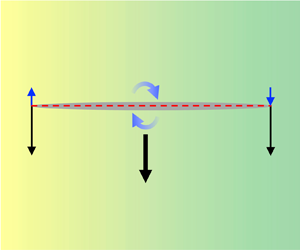Article contents
Resistive-force theory of slender bodies in viscosity gradients
Published online by Cambridge University Press: 19 May 2023
Abstract

In many natural settings, spatial variations in a fluid's viscosity arise due to changes in its local physico-chemical environment. We consider the low-Reynolds-number dynamics of slender bodies in fluids with a linearly varying viscosity. Assuming the spatial change in viscosity to be small compared to the spatial deviation of the body but large relative to the body's aspect ratio, we derive the modifications to resistive-force theory in a fluid due to a constant viscosity gradient. At leading order in the body slenderness, the results are identical to the classical theory in a constant-viscosity fluid but with the viscosity taking everywhere its local, non-constant value. At next order in slenderness, non-local terms arise due to the non-zero viscosity gradient. We use our results to predict the motion of straight and toroidal filaments settling under the action of gravity. We show that viscosity gradients induce rigid-body rotation of the filaments at a rate proportional to the components of the gradients along the filaments. This result contrasts with constant-viscosity fluids where the filaments do not rotate. We demonstrate further that if the viscosity gradient acts in the direction opposite to the gravitational field, then the filaments rotate towards a stable orientation, whose value depends on the ratio between the viscosity gradients parallel and perpendicular to the gravitational field; otherwise, the filaments align in the direction of the gravitational field. Our work shows that viscosity gradients can exert new forces on slender bodies, which could, for example, be used to control their orientation and drift.
JFM classification
- Type
- JFM Papers
- Information
- Copyright
- © The Author(s), 2023. Published by Cambridge University Press
References
- 6
- Cited by



